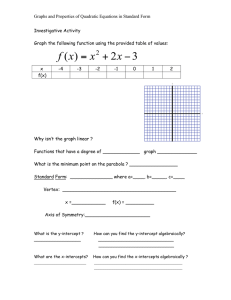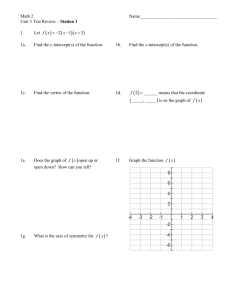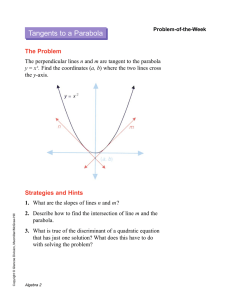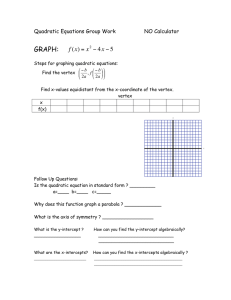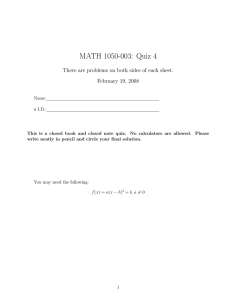Sketching Parabolas and Quadratics Powerpoint
advertisement
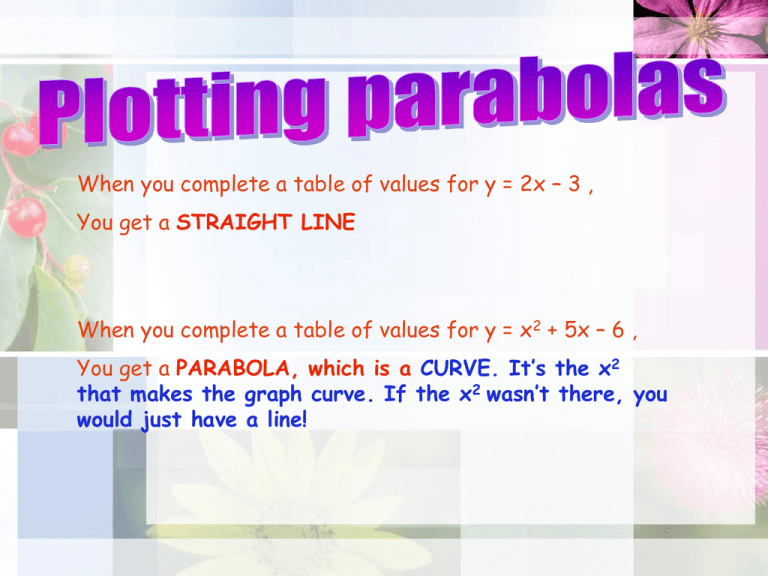
When you complete a table of values for y = 2x – 3 , You get a STRAIGHT LINE When you complete a table of values for y = x2 + 5x – 6 , You get a PARABOLA, which is a CURVE. It’s the x2 that makes the graph curve. If the x2 wasn’t there, you would just have a line! So let’s try plotting y = x2 – 5x + 6 using a table of values. First choose a few x-values and make sure they’re in order and spaced 1 apart. Now one by one, put these into the equation y = x2 - 5x + 6, being sure to bracket negatives when squaring them (they become positives!!) Begin with x = -2 (–2)2 – 5 (– 2) + 6 = 4 + 10 + 6 = 20 So our first point is (2, 20) X -2 -1 0 1 2 3 4 5 6 7 8 Y Now continue the same process for the rest of the numbers. And plot them on a grid and join with a smooth curve y 30 26 22 18 14 10 6 2 x -6 -10 X -2 -1 0 1 2 3 4 5 6 7 8 Y 20 12 6 2 0 0 2 6 12 20 30 There is an alternative to the sometimes laborious “box” method of plotting parabolas. This alternative uses the y-intercept, the xintercepts and the turning point to get a graph. Once you become practised at this you will find it quicker than boxes and substitution. When you solve a quadratic such as 0 = x2 + x - 6 You are actually finding the two x-intercepts of the parabola y = 0 at these 2 pts y = x2 + x - 6 because these are the points where y = 0 So here we go…. x2 +x-6=0 ( x + 3 )(x – 2) = 0 x = -3 or x = 2 This means that the parabola y = x2 + x - 6 will have xintercepts equal to -3 and 2 y = x2 + x - 6 y 5 3 1 x -3 -5 -7 -9 -11 -13 -15 x-intercepts are -3 and 2 Plot the graph of y = x2 – 5x + 6, by first finding the x and y intercepts, and its turning point. STEP 1 Start with the yintercept as it’s the easiest. It’s the yvalue you get when you make x = 0. It’s also very easy to recognise it as the number on its own, i.e. +6. So we now have our first point for our parabola….. x y 0 6 y-intercept (0, 6) y 5 4 3 2 1 x -1 -2 -3 -4 -5 STEP 2 Now we’ll do the x-intercepts – they require a bit more work. See “IMPORTANT INFO” on Slide #2. They’re the x-values you get when you make y = 0. So this means we have to solve the quadratic equation 0 = x2 – 5x + 6 . The process is a familiar one!!! Factorise then solve x2 – 5x + 6 = 0 First we factorise the quadratic so either which gives Δx◊=6 Δ + ◊ = -5 (x – 2)(x – 3) = 0 x – 2 = 0 or x – 3 = 0 x=2 x=3 gives -2 and -3 These are the x-intercepts So we now have 2 more points for our parabola….. x y 0 2 3 6 0 0 y-intercept (0, 6) y 5 4 3 2 1 -1 -2 -3 -4 -5 x STEP 3 Now for the TURNING POINT If your parabola is written as y = ax2 + b x + c, then the turning point’s coordinates can be found from the formula b 4ac b 2 , 4a 2a So in y = 1 x2 – 5 5x + 6 6, first write down what a, b and c are: a = 1 b = -5 c = 6 a = 1, b = -5, c = 6 so we substitute these values into our formula and use the calculator to work it out…. and this will give us our turning point b 4ac b , 4a 2a 5 4 1 6 ( 5)2 , 4 1 21 2 2.5,0.25 For the bright sparks! You may have noticed that the x-value of the turning point is always midway between the 2 x-intercepts. This is another reliable way of finding the turning point and avoids using the formula above! Here, x-intercepts were 2 and 3, so the turning point’s x-value is 2.5 ! Find y by substituting 2.5 into the formula y = x2 – 5x + 6 and this will give y = -0.25 So we now have another point for our parabola….. x y 0 2 3 2.5 6 0 0 -0.25 y-intercept (0, 6) y 5 4 axis of symmetry is the vertical line x = 2.5 3 2 1 x -1 -2 (2.5, –0.25) -3 -4 -5 Now you can plot the graph! You may wish to plot a few extra points to help with accuracy. Plot the graph of y = x2 + 2x - 8 using intercepts and turning point. State equation of axis of symmetry. STEP 1 – y intercept. This is the number on its own, STEP 2 – x intercepts. Found by making y = 0 and solving x2 + 2x – 8 = 0 x2 + 2x – 8 = 0 (x + 4)(x – 2) = 0 x + 4 = 0 OR x – 2 = 0 x = - 4 OR x = 2 x 0 y -8 -4 2 0 0 -8 STEP 3 – Turning point. a = 1, b = 2, c = -8 b 4ac b 2 , 4a 2a 2 2 4 1 8 2 , 4 1 21 1,9 y = x2 + 2x - 8 x 0 y -8 -4 2 -1 0 0 -9 y 5 3 1 x -3 -5 -7 -9 axis of symmetry x = -1 -11 -13 -15 (0, -8) y-intercept Plot the graph of y = 3x - x2 using intercepts and turning point. STEP 1 – y intercept. This is the “invisible” number on its own, 0 STEP 2 – x intercepts. Found by making y = 0 and solving 3x – x2 = 0 3x - x2 = 0 Sign change ….x2 – 3x = 0 x(x – 3) = 0 x = 0 OR x – 3 = 0 x = 0 OR x = 3 x 0 y 0 0 3 0 0 Note that here we get a repeat!! (0,0) STEP 3 – Turning point. a = -1, b = 3, c = 0 b 4ac b 2 , 4a 2a 2 3 4 1 0 3 , 4 1 2 1 1.5, 2.25 y = 3x - x2 x 0 y 0 0 0 3 0 1.5 2.25 y y-intercept AND one of the x-intercepts (0,0) 5 3 1 x -3 -5 -7 -9 -11 axis of symmetry x = 1-13 -15 Of the 3 parabolas we graphed, only the last one had a negative in front of the x2. Its graph was upside down! The entrance to a railway tunnel forms a parabolic arch. At any distance d across the base of the tunnel, starting from the left, the height h is found using the equation h 2 h = -d + 6d d We can represent the tunnel as a graph….see over y 10 From this diagram you can see that………… 9 h = -d2 + 6d 8 7 the base of the tunnel is 6m wide becomes 6 the height of the tunnel is 9m at its highest point y = -x2 + 6x 5 for graph drawing purposes 4 3 A train is 4m wide and 4m tall. Would it be able to pass through? 4m 2 YES! But only just! 1 x 0 y 10 9 How high is the tunnel 1m along the base from either side of the tunnel? 8 7 The base points are at 1 and 5. Moving up to meet the graph, we can see that these will be 5 up. The tunnel is therefore 5m high at points 1m in from either side 6 5 4 3 2 1 x 0 In all these questions you must aim to eventually end up with a STANDARD QUADRATIC FORMAT, which looks like 2 ax + bx + c = 0 where the a, b and c are just numbers, and most importantly, you have ZERO on one side! Solve the equation x 2 3x 4 Must get 0 on one side, so subtract the 4: x2 + 3x – 4 = 0 This is now in regular quadratic format so factorise and follow normal routine…. x = -4 (x + 4)(x – 1) = 0 x+4=0 or Answers x–1=0 x=1 Solve the equation x 2 6 x Must get 0 on one side, so subtract the x and place it in the middle between the x2 and the -6: x2 - x – 6 = 0 This is now in regular quadratic format so factorise and follow normal routine…. x=3 (x - 3)(x + 2) = 0 x-3=0 or Answers x+2=0 x = -2 Solve the equation x 2 2x 24 Must get 0 on one side, so add x2: 0 = x2 + 2x - 24 This is now in regular quadratic format so factorise and follow normal routine…. x = -6 (x + 6)(x - 4) = 0 x+6 =0 or Answers x -4=0 x=4 6 Solve the equation x 5 x STEP 1 – get rid of any fractions. In this case, multiply all three terms by x x 2 5x 6 STEP 2 – make 0 on right hand side. In this case, take 6 from both sides x 2 5x 6 0 STEP 3 – Factorise and solve using familiar routine (x 6)(x 1) 0 So…. x = 6 or x = -1
